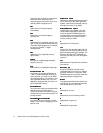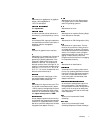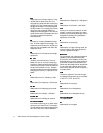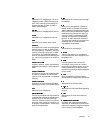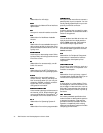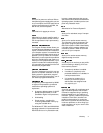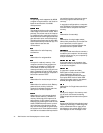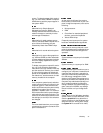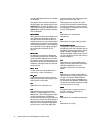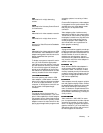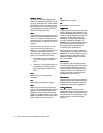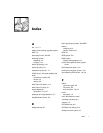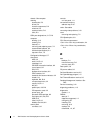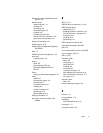
14 Dell Precision 210 Desktop Systems User’s Guide
mouse, and keyboard drivers are installed
for Windows.
Running the Control Panel or Windows
Setup program may change options in the
system.ini file. On other occasions, you
may need to change or add options to the
system.ini file manually with a text editor,
such as Notepad.
Some devices must be terminated to pre-
vent reflections and spurious signals in
the cable. When such devices are con-
nected in a series, you may need to enable
or disable the termination on these devic-
es by changing jumper or switch settings
on the devices or by changing settings in
the configuration software for the
devices.
An application program for editing text
files consisting exclusively of ASCII char-
acters. Windows Notepad is a text editor,
for example. Most word processors use
proprietary file formats containing binary
characters, although some can read and
write text files.
A video mode that can be defined as
x
columns by
y
rows of characters.
A specified period of system inactivity
that must occur before an energy conser-
vation feature is activated.
Abbreviation for tracks per inch.
Abbreviation for terminate-and-stay-
resident. A TSR program runs “in the
background.” Most TSR programs imple-
ment a predefined key combination
(sometimes referred to as a
hot key
) that
allows you to activate the TSR program’s
interface while running another program.
When you finish using the TSR program,
you can return to the other application
program and leave the TSR program resi-
dent in memory for later use.
TSR programs can sometimes cause
memory conflicts. When troubleshooting,
rule out the possibility of such a conflict
by rebooting your computer without start-
ing any TSR programs.
Abbreviation for Underwriters
Laboratories.
Abbreviation for upper memory blocks.
The 384 KB of RAM located between
640 KB and 1 MB. If the computer has an
Intel386 or higher microprocessor, a utility
called a
memory manager
can create
UMBs in the upper memory area, in which
you can load device drivers and memory-
resident programs.
Abbreviation for uninterruptible power
supply. A battery-powered unit that auto-
matically supplies power to your
computer in the event of an electrical
failure.
Abbreviation for Universal Serial Bus. A
USB connector provides a single connec-
tion point for multiple USB-compliant
devices, such as mice, keyboards, print-
ers, and computer speakers. USB devices
can also be connected and disconnected
while the system is running.
A program used to manage system re-
sources—memory, disk drives, or
printers, for example.
Abbreviation for unshielded twisted pair.
Abbreviation for volt(s).



